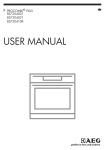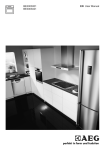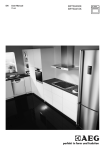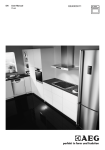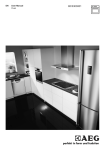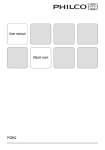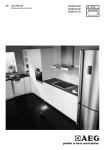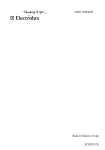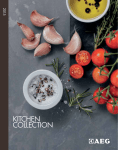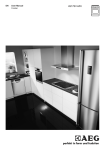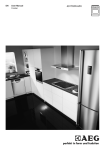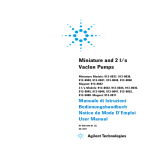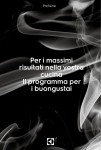Download BS9354001 BS935400W BS9354071 BS9354151 EN User Manual
Transcript
BS9354001 BS935400W BS9354071 BS9354151 EURO Appliances - euappliances.info EN User Manual 2 www.aeg.com CONTENTS 1. SAFETY INFORMATION.................................................................................................3 2. SAFETY INSTRUCTIONS................................................................................................ 4 3. PRODUCT DESCRIPTION.............................................................................................. 6 4. CONTROL PANEL...........................................................................................................8 5. BEFORE FIRST USE.........................................................................................................9 6. DAILY USE......................................................................................................................10 7. CLOCK FUNCTIONS.................................................................................................... 15 8. AUTOMATIC PROGRAMMES......................................................................................16 9. USING THE ACCESSORIES..........................................................................................17 10. ADDITIONAL FUNCTIONS........................................................................................19 11. HINTS AND TIPS......................................................................................................... 20 12. CARE AND CLEANING.............................................................................................. 46 13. TROUBLESHOOTING.................................................................................................49 FOR PERFECT RESULTS Thank you for choosing this AEG product. We have created it to give you impeccable performance for many years, with innovative technologies that help make life simpler features you might not find on ordinary appliances. Please spend a few minutes reading to get the very best from it. Visit our website for: Get usage advice, brochures, trouble shooter, service information: www.aeg.com Register your product for better service: www.registeraeg.com Buy Accessories, Consumables and Original spare parts for your appliance: www.aeg.com/shop CUSTOMER CARE AND SERVICE Always use original spare parts. When contacting our Authorised Service Centre, ensure that you have the following data available: Model, PNC, Serial Number. The information can be found on the rating plate. Warning / Caution-Safety information General information and tips Environmental information Subject to change without notice. EURO Appliances - euappliances.info ENGLISH 1. 3 SAFETY INFORMATION Before the installation and use of the appliance, carefully read the supplied instructions. The manufacturer is not responsible if an incorrect installation and use causes injuries and damages. Always keep the instructions with the appliance for future reference. 1.1 Children and vulnerable people safety • • • • • • • This appliance can be used by children aged from 8 years and above and persons with reduced physical, sensory or mental capabilities or lack of experience and knowledge if they have been given supervision or instruction concerning use of the appliance in a safe way and understand the hazards involved. Do not let children play with the appliance. Keep all packaging away from children. Keep children and pets away from the appliance when it operates or when it cools down. Accessible parts are hot. If the appliance has a child safety device, we recommend you activate it. Cleaning and user maintenance shall not be made by children without supervision. Children of less than 3 years should be kept away unless continuously supervised. 1.2 General Safety • • • Only a qualified person must install this appliance and replace the cable. Internally the appliance becomes hot when in operation. Do not touch the heating elements that are in the appliance. Always use oven gloves to remove or put in accessories or ovenware. Before maintenance cut the power supply. EURO Appliances - euappliances.info 4 www.aeg.com • • • • • • Ensure that the appliance is switched off before replacing the lamp to avoid the possibility of electric shock. Do not use a steam cleaner to clean the appliance. Do not use harsh abrasive cleaners or sharp metal scrapers to clean the glass door since they can scratch the surface, which may result in shattering of the glass. If the supply cord is damaged, it must be replaced by the manufacturer, its Authorised Service Centre or similarly qualified persons in order to avoid a hazard. To remove the shelf supports first pull the front of the shelf support and then the rear end away from the side walls. Install the shelf supports in the opposite sequence. Only use the core temperature sensor recommended for this appliance. 2. SAFETY INSTRUCTIONS 2.1 Installation WARNING! Only a qualified person must install this appliance. • Remove all the packaging. • Do not install or use a damaged appliance. • Obey the installation instruction supplied with the appliance. • Always be careful when you move the appliance because it is heavy. Always wear safety gloves. • Do not pull the appliance by the handle. • Keep the minimum distance from the other appliances and units. • Make sure that the appliance is installed below and adjacent safe structures. • The sides of the appliance must stay adjacent to appliances or to units with the same height. EURO Appliances - euappliances.info 2.2 Electrical connection WARNING! Risk of fire and electrical shock. • All electrical connections should be made by a qualified electrician. • The appliance must be earthed. • Make sure that the electrical information on the rating plate agrees with the power supply. If not contact an electrician. • Always use a correctly installed shockproof socket. • Do not use multi-plug adapters and extension cables. • Make sure not to cause damage to the mains plug and to the mains cable. Should the mains cable need to be replaced, this must be carried out by our Authorised Service Centre. • Do not let mains cables to come in touch with the appliance door, specially when the door is hot. • The shock protection of live and insulated parts must be fastened in such a way that it cannot be removed without tools. ENGLISH • Connect the mains plug to the mains socket only at the end of the installation. Make sure that there is access to the mains plug after the installation. • If the mains socket is loose, do not connect the mains plug. • Do not pull the mains cable to disconnect the appliance. Always pull the mains plug. • Use only correct isolation devices: line protecting cut-outs, fuses (screw type fuses removed from the holder), earth leakage trips and contactors. • The electrical installation must have an isolation device which lets you disconnect the appliance from the mains at all poles. The isolation device must have a contact opening width of minimum 3 mm. • This appliance complies with the E.E.C. Directives. 2.3 Use WARNING! Risk of injury, burns and electrical shock or explosion. • Use this appliance in a household only. • Do not change the specification of this appliance. • Make sure that the ventilation openings are not blocked. • Do not let the appliance stay unattended during operation. • Deactivate the appliance after each use. • Be careful when you open the appliance door while the appliance is in operation. Hot air can release. • Do not operate the appliance with wet hands or when it has contact with water. • Do not apply pressure on the open door. • Do not use the appliance as a work surface or as a storage surface. • Open the appliance door carefully. The use of ingredients with alcohol can cause a mixture of alcohol and air. • Do not let sparks or open flames to come in contact with the appliance when you open the door. EURO Appliances - euappliances.info 5 • Do not put flammable products or items that are wet with flammable products in, near or on the appliance. WARNING! Risk of damage to the appliance. • To prevent damage or discoloration to the enamel: – do not put ovenware or other objects in the appliance directly on the bottom. – do not put aluminium foil directly on the bottom of the appliance. – do not put water directly into the hot appliance. – do not keep moist dishes and food in the appliance after you finish the cooking. – be careful when you remove or install the accessories. • Discoloration of the enamel has no effect on the performance of the appliance. It is not a defect in the sense of the warranty law. • Use a deep pan for moist cakes. Fruit juices cause stains that can be permanent. • This appliance is for cooking purposes only. It must not be used for other purposes, for example room heating. • Always cook with the oven door closed. 2.4 Steam Cooking WARNING! Risk of burns and damage to the appliance. • Released Steam can cause burns: – Do not open the appliance door during the steam cooking operation. – Open the appliance door with care after the steam cooking operation. 2.5 Care and cleaning WARNING! Risk of injury, fire, or damage to the appliance. 6 www.aeg.com • Before maintenance, deactivate the appliance and disconnect the mains plug from the mains socket. • Make sure the appliance is cold. There is the risk that the glass panels can break. • Replace immediately the door glass panels when they are damaged. Contact the Service. • Be careful when you remove the door from the appliance. The door is heavy! • Clean regularly the appliance to prevent the deterioration of the surface material. • Remaining fat or food in the appliance can cause fire. • Clean the appliance with a moist soft cloth. Only use neutral detergents. Do not use abrasive products, abrasive cleaning pads, solvents or metal objects. • If you use an oven spray, obey the safety instructions on the packaging. • Do not clean the catalytic enamel (if applicable) with any kind of detergent. 2.6 Internal light • The type of light bulb or halogen lamp used for this appliance is only for household appliances. Do not use it for house lighting. WARNING! Risk of electrical shock. • Before replacing the lamp, disconnect the appliance from the power supply. • Only use lamps with the same specifications. 2.7 Disposal WARNING! Risk of injury or suffocation. • Disconnect the appliance from the mains supply. • Cut off the mains cable and discard it. • Remove the door catch to prevent children and pets to get closed in the appliance. 3. PRODUCT DESCRIPTION 3.1 General overview 1 2 3 4 5 6 5 4 10 3 7 2 1 8 9 EURO Appliances - euappliances.info 1 2 3 4 5 6 7 8 9 10 Control panel Electronic programmer Water drawer Socket for the core temperature sensor Heating element Lamp Fan Steam generator with cover Shelf support, removable Shelf positions ENGLISH 3.2 Accessories Wire shelf For cookware, cake tins, roasts. Baking tray 7 discolouration of the surface has no effect on the functions. Core temperature sensor To measure how far the food is cooked. Steam set For cakes and biscuits. Grill- / Roasting pan One unperforated and one perforated food container. To bake and roast or as a pan to collect fat. The steam set drains the condensing water away from the food during steam cooking. Use it to prepare food that should not be in the water during the cooking (e.g. vegetables, pieces of fish, chicken breast). The set is not suitable for food that needs to soak in the water (e.g. rice, polenta, pasta). Patisserie tray Sponge For rolls, brezels and small pastries. Suitable for steam functions. The EURO Appliances - euappliances.info For absorbing the remaining water from the steam generator. 8 www.aeg.com 4. CONTROL PANEL 4.1 Electronic programmer 1 2 3 4 5 6 7 8 9 Use the sensor fields to operate the appliance. Sensor field 1 2 3 4 - Function Comment Display Shows the current settings of the appliance. ON / OFF To activate and deactivate the appliance. OK and shuttle To confirm the selection or setting. Rotate the shuttle to navigate. Home key To show the main menu. Time and additional functions To set different functions. When a heating function operates, touch the sensor field to set the timer or the functions: Function Lock, Favourite Programme, Heat + Hold, Set + Go. You can also change the settings of the core temperature sensor. Heating Functions or Assisted Cooking To choose a heating function, touch the sensor field once. To choose the menu: Assisted Cooking, touch it twice. To activate or deactivate the light, touch the field for 3 seconds. 5 6 7 8 9 Temperature selec- To set the temperature or show the current tempertion ature in the appliance. Touch the field for 3 seconds, to activate or deactivate the function: Fast heat up. Minute Minder To set the function: Minute Minder. Favourite Programme To view your favourite programmes. EURO Appliances - euappliances.info ENGLISH 4.2 Display A B C E D A) B) C) D) E) Heating function Time of day Heat-up indicator Temperature Duration time or end time of a function Other indicators of the display: Symbol Function Minute Minder The function operates. Time of day The display shows the current time. Duration The display shows the necessary time for cooking. End Time The display shows when the cooking time is complete. Temperature The display shows the temperature. Time Indication The display shows how long the heating function operates. Calculation The appliance calculates the time for cooking. Heat-up Indicator The display shows the temperature in the appliance. Fast Heat Up Indicator The function is active. It decreases the heat up time. Weight Automatic The display shows that the automatic weight system is active or that weight can be changed. Heat + Hold The function is active. 5. BEFORE FIRST USE WARNING! Refer to Safety chapters. 5.1 Initial Cleaning Remove all accessories and removable shelf supports from the appliance. EURO Appliances - euappliances.info Refer to "Care and cleaning" chapter. Clean the appliance before first use. Put the accessories and the removable shelf supports back to their initial position. 9 10 www.aeg.com 5.2 First Connection When you connect the appliance to the mains or after the power cut, you have to set the language, the display contrast, the display brightness and the time of the day. 1. Use the shuttle to set the values. 2. Press to confirm. 6. DAILY USE 3. Press to move to the submenu or accept the setting. WARNING! Refer to Safety chapters. At each point you can go back to the main menu with 6.1 Navigating the menus 1. Activate the appliance. 2. Use the shuttle clockwise or counterclockwise to select the menu option. . 6.2 The menus in overview Main menu Symbol Menu item Application Heating Functions Contains a list of heating functions. SousVide cooking Contains a heating function and a list of automatic programmes. Assisted Cooking Contains a list of automatic programmes. Assisted Cleaning Contains a list of cleaning programmes. Basic Settings You can use it to set other settings. Favourite Programme Contains a list of favourite cooking programmes created by the user. Submenu for: Basic Settings Symbol Submenu Description Set Time of Day Sets the current time on the clock. Time Indication When ON, the display shows the current time when you deactivate the appliance. Set + Go When ON, in the Select Options window you can choose the function: Set + Go. Heat + Hold When ON, in the Select Options window you can choose the function: Heat + Hold. EURO Appliances - euappliances.info ENGLISH Symbol Submenu Description Extra Time Activates and deactivates the time extension function. Display Contrast Adjusts the display contrast by degrees. Display Brightness Adjusts the display brightness by degrees. Set Language Sets the language for the display. Buzzer Volume Adjusts the volume of press-tones and signals by degrees. Key Tones Activates and deactivates the tone of the touch fields. It is not possible to deactivate the tone of the ON / OFF touch field. Alarm/Error Tones Activates and deactivates the alarm tones. Cleaning Assistant Guides you through the cleaning procedure. Service Shows the software version and configuration. Factory Settings Resets all settings to factory settings. 6.3 Submenu for: SousVide cooking This technique has its start in the Sousvide technology, which in French means Symbol "under vacuum". The name refers to a method of cooking in vacuum sealed plastic pouches at low temperatures. Menu item Description SousVide Cooking mode Uses the steam for meat, fish, seafood, vegetables and fruits. Set the temperature 50 °C - 95 °C. SousVide recipes Contains a list of automatic programmes. 6.4 Submenu for: Assisted Cleaning Symbol 11 Menu item Description Steam Cleaning Cleaning the appliance with steam. Decalcification Cleaning the steam generator. EURO Appliances - euappliances.info 12 www.aeg.com 6.5 Heating Functions Heating function Application Full Steam For vegetables, fish, potatoes, rice, pasta or special side-dishes. Half Steam + Heat For dishes with a high moisture content and for poaching fish, custard royale and terrines. Quarter Steam + Heat To bake bread, roast large pieces of meat or to warm up chilled and frozen meals. ECO Steam The ECO functions let you optimize the energy consumption during cooking. It is necessary to set the cooking time first. To get more information about the recommended settings, refer to the cooking tables with the equivalent function. Moist Fan Baking To save energy when you bake and cook dry baked goods. Also to bake baked goods in tins on 1 shelf position. This function was used to define the energy efficiency class acc. EN50304. True Fan Cooking To bake on up to 3 shelf positions at the same time and to dry food. Pizza Setting To bake food on 1 shelf position for a more intensive browning and a crispy bottom. Slow Cooking To prepare tender, succulent roasts. Conventional Cooking To bake and roast food on 1 shelf position. Frozen Foods To make your convenience food like e.g. French Fries, Wedges, spring rolls crispy. Turbo Grilling To roast larger meat joints or poultry with bones on 1 shelf position. Also to make gratins and to brown. Fast Grilling To grill flat food in large quantities and to toast bread. Grilling To grill flat food and to toast bread. Keep Warm To keep food warm. EURO Appliances - euappliances.info ENGLISH Heating function Application Defrost To defrost frozen food. Bottom Heat To bake cakes with crispy bottom and to preserve food. Dough Proving For controlled rising of yeast dough before baking. Bread Baking To bake bread. Au Gratin For dishes such as lasagna or potato gratin. Also to gratinate and brown. Preserving To make vegetable preserves such as pickles. Drying To dry sliced fruit (e.g. apples, plums, peaches) and vegetables (e.g. tomatoes, zucchini, mushrooms). Plate Warming To preheat your plate for serving. Steam Regenerating To reheat already cooked food directly on a plate. ECO Roasting The ECO functions let you optimize the energy consumption during cooking. It is necessary to set the cooking time first. To get more information about the recommended settings, refer to the cooking tables with the equivalent function. 6.6 Activating a heating function 1. Activate the appliance. 2. Select the menu: Heating Functions. 3. Press to confirm. 4. Set a heating function. 5. Press to confirm. 6. Set the temperature. 7. Press 13 to confirm. Press once or twice to go directly to the menus: Heating Functions, Assisted Cooking. EURO Appliances - euappliances.info 6.7 Steam cooking The water drawer cover is in the control panel. WARNING! Do not put water directly into the steam generator. Use only water. Do not use filtered (demineralised) or distilled water. Do not use other liquids. Do not put flammable or alcoholic liquids into the water drawer. 14 www.aeg.com 1. Prepare the food in the correct cookware. 2. Press the cover of the water drawer to open it. 3. Fill the water drawer with 800 ml of water. The water supply is sufficient for approximately 50 minutes. 4. Push the water drawer to its initial position. 5. Activate the appliance. 6. Select a steam heating function and the temperature. 7. If necessary, set the function Duration or End Time . The first steam shows after approximately 2 minutes. An acoustic signal sounds when the appliance is at approximately the set temperature. When the steam generator is empty, an acoustic signal sounds. The signal sounds at the end of the cooking time. 8. Deactivate the appliance. 9. Empty the water drawer after the steam cooking is completed. CAUTION! The appliance is hot. There is a risk of burns. Be careful when you empty the water drawer. When the appliance cools down, soak up all remaining water from the steam generator with the sponge. If necessary, clean the steam generator with some vinegar. Let the appliance dry fully with the door open. 6.8 SousVide cooking • With no evaporative losses of flavour volatiles and moisture, food keeps its full aroma • Tender texture of meat and fish • Food keeps all minerals and vitamins • Less spices are necessary as food keeps its natural flavour • Better workflow as it is not necessary to prepare and serve food at the same time and place • Low cooking temperature minimizes the risk of overcooking EURO Appliances - euappliances.info • Portioning of the food makes it easy to hold Preparing the food 1. Clean and cut the ingredients. 2. Season the ingredients. 3. Fill the ingredients in suitable vacuum bags. 4. Vacuum seal the bag to make sure that you remove as much air as possible. 5. Cold storage of the bags is mandatory in case the cooking procedure is not done immediately. 6. Continue with the function: SousVide cooking following applicable cooking table indications for the considered type of food or the assisted cooking recipes. 7. Open the pouch and serve. 8. Optional: finish the food with a final searing or grilling e.g. for meat to achieve a nice crust and the typical roast flavour. Activating a function: SousVide Cooking mode 1. Activate the appliance. 2. Select the menu: SousVide cooking. to confirm. 3. Press 4. Set the function: SousVide Cooking mode. 5. Press to confirm. 6. Set the temperature. 7. Press to confirm. 6.9 Heat-up indicator When you activate a heating function, the bar on the display comes on. The bar shows that the temperature increases. 6.10 Fast Heat Up Indicator This function decreases the heat-up time. for 3 To activate the function, hold seconds. The heat-up indicator alternates. ENGLISH 6.11 Residual heat When you deactivate the appliance, the display shows the residual heat. You can use the heat to keep the food warm. 6.12 Energy saving The appliance contains features which help you save energy during everyday cooking: • Residual heat – When the heating function or programme operates, the heating elements are deactivated 10% earlier (the lamp and fan continue to operate). For this feature to operate, the cooking time must be longer than 30 minutes or you must use the clock functions (Duration, End Time). 15 – When the appliance is off, you can use the heat to keep food warm. The display shows the remaining temperature. • Cooking with the lamp off - touch and hold for 3 seconds to deactivate the lamp during cooking. • Eco functions - refer to "Heating Functions". • When you use the function: Moist Fan Baking, the lamp deactivates after 30 seconds. The lamp activates again when you touch for 3 seconds or when you open the appliance door. • When you use the Eco functions, the lamp deactivates. The lamp activates for 3 again when you touch seconds or when you open the appliance door. 7. CLOCK FUNCTIONS 7.1 Clock functions table Clock function Application Minute Minder To set a countdown (max. 2 h 30 min). This function has no effect on the operation of the appliance. You can also activate it when the appliance is deactivated. Press to activate the function. Use the shuttle to set the minutes and to start. Duration To set the length of an operation (max. 23 h 59 min). End Time To set the switch-off time for a heating function (max. 23 h 59 min). If you set the time for a clock function, the time starts to count down after 5 seconds. If you use the clock functions: Duration, End Time, the appliance deactivates the heating elements after 90 % of the set time. The appliance uses the residual heat to continue the cooking process until the time ends (3 - 20 minutes). EURO Appliances - euappliances.info 16 www.aeg.com 7.2 Setting the clock functions • Before you use the functions: Duration, End Time, you must set a heating function and temperature first. The appliance deactivates automatically. • You can use the functions: Duration and End Time at the same time if you want to automatically activate and deactivate the appliance on a given time later. • The functions: Duration and End Time do not work when you use the core temperature sensor. 1. Set a heating function. 2. Press again and again until the display shows the necessary clock function and the related symbol. 3. Use the shuttle to set the necessary time. to confirm. 4. Press When the time ends, an acoustic signal sounds. The appliance deactivates. The display shows a message. 5. Press a sensor field to stop the signal. 7.3 Heat + Hold Conditions for the function: • The set temperature is more than 80 °C. • The function: Duration is set. The function: Heat + Hold keeps prepared food warm at 80 °C for 30 minutes. It activates after the baking or roasting procedure ends. You can activate or deactivate the function in the menu: Basic Settings. 1. Activate the appliance. 2. Select the heating function. 3. Set the temperature above 80 °C. 4. Press again and again until the display shows: Heat + Hold. to confirm. 5. Press When the function ends, an acoustic signal sounds. The function stays on if you change the heating functions. 7.4 Extra Time The function: Extra Time makes the heating function continue after the end of Duration. Applicable to all heating functions with Duration or Weight Automatic. Not applicable to heating functions with the core temperature sensor. 1. When the cooking time ends, an acoustic signal sounds. Press a sensor field. The display shows the message. to activate or to 2. Press cancel. 3. Set the length of the function. 4. Press . 8. AUTOMATIC PROGRAMMES WARNING! Refer to Safety chapters. EURO Appliances - euappliances.info 8.1 Recipes online You can find the recipes for the automatic programmes specified for this appliance on our website. To find the proper Recipe Book check the PNC number on the rating plate on the front frame of the appliance cavity. ENGLISH 8.2 Assisted Cooking with Recipe Automatic This appliance has a set of recipes you can use. The recipes are fixed and you cannot change them. 1. Activate the appliance. 2. Select the Assisted Cooking menu. Press to confirm. 3. Select the category and dish. Press to confirm. 4. Select a recipe. Press to confirm. When you use the Manual function, the appliance uses the automatic settings. You can change them as with other functions. 8.3 Assisted Cooking with Weight Automatic 17 1. Activate the appliance. 2. Select the menu: Assisted Cooking. Press to confirm. 3. Select the category and dish. Press to confirm. 4. Select the function: Weight to confirm. Automatic. Press 5. Use the shuttle to set the food weight. Press to confirm. The automatic programme starts. 6. You can change the weight at any time. Use the shuttle to change the weight. 7. When the time ends, an acoustic signal sounds. Press a sensor field to deactivate the signal. With some programmes turn over the food after 30 minutes. The display shows a reminder. This function automatically calculates the roasting time. To use it, it is necessary to input the food weight. 9. USING THE ACCESSORIES WARNING! Refer to Safety chapters. 9.1 Core temperature sensor 2. Put the tip of the core temperature sensor into the centre of the meat. 3. Put the plug of the core temperature sensor into the socket at the front of the appliance. There are two temperatures to be set: the oven temperature and the core temperature. The core temperature sensor measures the core temperature of the meat. When the meat is at the set temperature, the appliance deactivates. CAUTION! Only use the core temperature sensor supplied or the correct replacement parts. The core temperature sensor must stay in the meat and in the socket during the cooking. 1. Activate the appliance. EURO Appliances - euappliances.info The display shows the core temperature sensor symbol. 4. Use the shuttle in less than 5 seconds to set the core temperature. 5. Set the heating function and, if necessary, the oven temperature. 18 www.aeg.com The appliance calculates an approximate end time. The end time is different for the different quantities of the food, the set oven temperatures (minimum 120 °C) and the operating modes. The appliance calculates the end time in approximately 30 minutes. 6. To change the core temperature, press . When the meat is at the set core temperature, an acoustic signal sounds. The appliance deactivates automatically. 7. Touch a sensor field to stop the signal. 8. Remove the core temperature sensor plug from the socket and remove the meat from the oven. WARNING! The core temperature sensor is hot. There is a risk of burns. Be careful when you remove the tip and the plug of the core temperature sensor. Deep pan: Push the deep pan between the guide bars of the shelf support. Wire shelf and the deep pan together: Push the deep pan between the guide bars of the shelf support and the wire shelf on the guide bars above. 9.2 Inserting the accessories CAUTION! Do not use the baking tray or deep pan with the function: Full Steam. Wire shelf: Push the shelf between the guide bars of the shelf support and make sure that the feet point down. EURO Appliances - euappliances.info • All accessories have small indentations at the top of the right and left side to increase safety. The indentations are also antitip devices. • The high rim around the shelf is a device which prevents cookware from slipping. ENGLISH 19 10. ADDITIONAL FUNCTIONS 10.1 Favourite Programme You can save your favourite settings, such as duration, temperature or heating function. They are available in the menu: Favourite Programme. You can save 20 programmes. Saving a programme 1. Activate the appliance. 2. Set a heating function or an automatic programme. 3. Touch again and again until the display shows: SAVE. to confirm. 4. Press The display shows the first free memory position. 5. Press to confirm. 6. Enter the name of the programme. The first letter flashes. 7. Use the shuttle to change the letter. . 8. Press The next letter flashes. 9. Do step 7 again as necessary. 10. Press and hold to save. To save your favourite programme you can also touch and hold display shows: SAVE. until the You can overwrite a memory position. When the display shows the first free memory position, use the shuttle and press to overwrite an existing programme. You can change the name of a programme in the menu: Edit Programme Name. Activating the programme 1. Activate the appliance. 2. Select the menu: Favourite Programme. 3. Press to confirm. 4. Select your favourite programme name. 5. Press to confirm. EURO Appliances - euappliances.info Press to go directly to menu: Favourite Programme. You can also use it when the appliance is deactivated. 10.2 Using the Child Lock The Child Lock prevents an accidental operation of the appliance. 1. Activate the appliance. and at the same time 2. Touch until the display shows a message. To deactivate the Child Lock function repeat step 2. 10.3 Function Lock This function prevents an accidental change of the heating function. You can activate it only when the appliance operates. 1. Activate the appliance. 2. Set a heating function or setting. again and again until the 3. Press display shows: Function Lock. 4. Press to confirm. To deactivate the function, press . The display shows a message. Press again and then to confirm. 10.4 Set + Go The function lets you set a heating function (or a programme) and use it later with one press of a sensor field. 1. Activate the appliance. 2. Set a heating function. again and again until the 3. Press display shows: Duration. 4. Set the time. again and again until the 5. Press display shows: Set + Go. 6. Press to confirm. Press a sensor field (except for ) to start the function: Set + Go. The set heating function starts. When the heating function ends, an acoustic signal sounds. 20 www.aeg.com 10.6 Brightness of the display • Function Lock is on when the heating function operates. • The menu: Basic Settings lets you activate and deactivate the function: Set + Go. 10.5 Automatic Switch-off For safety reasons the appliance deactivates automatically after some time if a heating function operates and you do not change any settings. Temperature (°C) Switch-off time (h) 30 - 115 12.5 120 - 195 8.5 200 - 230 5.5 The Automatic switch-off does not work with the functions: Light, core temperature sensor, End Time, Duration. There are two modes of display brightness: • Night brightness - when the appliance is deactivated, the brightness of the display is lower between 10 PM and 6 AM. • Day brightness: – when the appliance is activated. – if you touch a sensor field during the night brightness (apart from ON / OFF), the display goes back to the day brightness mode for the next 10 seconds. – if the appliance is deactivated and you set the function: Minute Minder. When the function ends, the display goes back to the night brightness. 10.7 Cooling fan When the appliance operates, the cooling fan activates automatically to keep the surfaces of the appliance cool. If you deactivate the appliance, the cooling fan can continue to operate until the appliance cools down. 11. HINTS AND TIPS WARNING! Refer to Safety chapters. The temperature and baking times in the tables are guidelines only. They depend on the recipes and the quality and quantity of the ingredients used. 11.1 Inner side of the door In some models, on the inner side of the door you can find: • the numbers of the shelf positions. • information about the heating functions, recommended shelf positions and temperatures for typical dishes. 11.2 Advice for special heating functions of the oven Keep Warm Use this function if you want to keep food warm. The temperature regulates itself automatically to 80 °C. Plate Warming For warming plates and dishes. Distribute plates and dishes evenly on the wire shelf. Move stacks around after half of the warming time (swap top and bottom). The automatic temperature is 70 °C. Recommended shelf position: 3. EURO Appliances - euappliances.info ENGLISH Dough Proving You can use this automatic function with any recipe for yeast dough you like. It gives you a good atmosphere for rising. Put the dough into a dish that is big enough for rising and cover it with a wet towel or plastic foil. Insert a wire shelf on the first shelf position and put the dish in. Close the door and set the function: Dough Proving. Set the necessary time. 11.3 SousVide cooking This function uses lower cooking temperatures than normal cooking. Handle the food with special care for better food quality. Recommendations regarding food safety: • Use high quality raw materials. • Always use the raw material that is as fresh as possible. • Always keep raw materials in correct conditions before you cook them. • Always clean the food before you cook it. • For good and safe results, always look at the values in the cooking tables. Check the cooking time, temperature and dimension of the food. • Food should not be kept at a temperature below 60 °C for a longer time to avoid safety problems. • Use low temperatures only for food that could be eaten raw and only for a short time. • Sous-vide dishes have the best taste immediately after cooking. If you do not eat the food immediately after the cooking, quickly decrease its temperature. To do that, put the food in an ice bath and put it in the fridge. You can keep the food in the fridge for 2 – 3 days. • Do not use Sous-vide cooking function for reheating food leftovers. • Prevent contact between raw food and cooked food while you prepare and cook the food. • Do not use the same tools for different things without washing them carefully. EURO Appliances - euappliances.info 21 • For recipes with raw eggs, prevent egg whites or yolks from contact with the external part of the egg shells. Hints and tips regarding food vacuum packing: • Necessary equipment for Sous-vide cooking function are a vacuum sealer and vacuum bags. • Recommended vacuum sealer type: chamber vacuum sealer. Only this type of vacuum sealer can vacuum pack liquids. • Use vacuum bags correct for Sousvide cooking function. • Do not reuse vacuum bags. • Put the food in one layer of the vacuum bags to get an even cooking result. • For faster and more even cooking of the food, set the vacuum degree to the highest possible. • To guarantee a safe closing of the vacuum bag, make sure that the area subject to the seal is clean. General hints and tips for the function SousVide cooking: • To keep the cooking steam, always keep the appliance door closed when you use Sous-vide cooking function. • Open the door carefully after cooking because there is steam cumulated in the appliance. • You can add oil and spices to the food in accordance to your taste. Oil prevents the food from sticking to the vacuum bag. • For faster and more even cooking of the food, keep the vacuum degree as high as possible. • Cooking times are recommendations and can be different in accordance to your preferences. • The cooking times in the cooking tables are for dishes for 4 people. If the quantity of the food is higher, the cooking times can be longer. • If the dimension of the food is different than the cooking tables show, the cooking time can change. • Put the vacuum bags on the grid without overlapping when using more bags. 22 www.aeg.com 11.4 SousVide cooking: Meat • Look at the tables to prevent undercooking. Do not use meat portions of a larger thickness than the tables show. • The cooking times in the tables are the minimum necessary times. The cooking time can be increased in accordance to personal preferences. • Use only boneless meat to avoid damages to the vacuum bags. • For the poultry fillets to taste better, fry them on the skin side before and after vacuum packing. Beef Food Thickness of food Amount of Temperafood for 4 ture (°C) persons (g) Time (min) Shelf posi- Water in tion the water drawer (ml) Beef fillet medium 4 cm 800 60 110 - 120 3 600 Beef fillet well done 4 cm 800 65 90 - 100 3 500 Lamb / Game Food Thickness of food Amount of Temperafood for 4 ture (°C) persons (g) Time (min) Shelf posi- Water in tion the water drawer (ml) Lamb rare 3 cm 600 - 650 60 180 - 190 3 700 Lamb medium 3 cm 600 - 650 65 105 - 115 3 600 Boar 3 cm 600 - 650 90 60 - 70 3 800 + 200 Rabbit boneless 1.5 cm 600 - 650 70 50 - 60 3 600 Food Thickness of food Amount of Temperafood for 4 ture (°C) persons (g) Time (min) Shelf posi- Water in tion the water drawer (ml) Chicken breast boneless 3 cm 750 70 70 - 80 3 700 Duck breast boneless 2 cm 900 65 100 - 110 3 500 Turkey breast boneless 2 cm 800 70 75 - 85 3 700 Poultry EURO Appliances - euappliances.info ENGLISH 11.5 SousVide cooking: Fish and seafood • Dry the fish fillets with a paper towel before you put them in a vacuum bag. • Add a cup of water in the vacuum bag when you cook the mussels. • Look at the table to prevent undercooking. Do not use fish portions of a larger thickness than the table show. Food Thickness of food Sea bream fillet Temperature (°C) Time (min) Shelf position Water in the water drawer (ml) 4 fillets 1 cm 500 70 25 3 400 Sea bass fil- 4 fillets 1 cm 500 let 70 25 3 400 Cod fish 2 fillets 2 cm 650 65 70 - 75 3 600 Scallops big size 650 60 100 110 3 500 1000 95 20 - 25 3 500 500 75 26 - 30 3 400 1000 85 100 110 3 800 + 200 Mussels with shell Prawns without shell big size Octopus Trout fil- Amount of food for 4 persons (g) 23 2 fillets 1.5 cm 650 65 55 - 65 3 500 let 1) Salmon fil- 3 cm 800 65 100 110 3 600 let1) 1) To prevent protein leak soak the fish in a 10 % salt solution (100 g salt in 1 litre of water) for 30 min and dry with a paper towel before you put it in a vacuum bag. 11.6 SousVide cooking: Vegetables • Peel the vegetables where necessary. • Some vegetables can change their colour when you peel them and cook in a vacuum packing. For better EURO Appliances - euappliances.info results cook the food immediately after you prepare it. • To keep the colour of the artichokes, put them in water with lemon juice, after you clean and cut them. 24 www.aeg.com Food Thickness of food Amount of food for 4 persons (g) Temperature (°C) Time (min) Shelf position Water in the water drawer (ml) Asparagus whole green 700 - 800 90 40 - 50 3 600 Asparagus whole white 700 - 800 90 50 - 60 3 700 Courgette slices of 1 cm 700 - 800 90 35 - 40 3 500 Leek stripes or rings 600 - 700 95 40 - 45 3 700 Eggplant slices of 1 cm 700 - 800 90 30 - 35 3 500 Pumpkin pieces with thick- 700 - 800 ness of 2 cm 90 25 - 30 3 500 Pepper stripes or quarter 700 - 800 95 35 - 40 3 500 Celery rings of 1 cm 700 - 800 95 40 - 45 3 600 Carrots slices of 0.5 cm 700 - 800 95 35 - 45 3 700 Celery root slices of 1 cm 700 - 800 95 45 - 50 3 700 Fennel slices of 1 cm 700 - 800 95 35 - 45 3 700 Potatoes slices of 1 cm 800 - 1000 95 35 - 45 3 700 Artichoke hearts cut in quarter 400 - 600 95 45 - 55 3 800 11.7 SousVide cooking: Fruits • Peel the fruits, remove the seeds and cores where necessary • To keep the colour of the apples and pears, put them in water with lemon juice, after you clean and cut them. • For better results cook the food immediately after you prepare it. Food Thickness of food Amount of food for 4 persons (g) Temperature (°C) Time (min) Shel Water in f the water po- drawer (ml) sition Peach cut in halves 4 fruits 90 20 - 25 3 400 Plum cut in halves 600 g 90 10 - 15 3 300 Mango cut in cubes of about 2 x 2 cm 2 fruits 90 10 - 15 3 300 EURO Appliances - euappliances.info ENGLISH 25 Food Thickness of food Amount of food for 4 persons (g) Temperature (°C) Time (min) Shel Water in f the water po- drawer (ml) sition Nectarine cut in halves 4 fruits 90 20 - 25 3 400 Pineapple slices 1 cm 600 g 90 20 - 25 3 400 Apple cut in quarters 4 fruits 95 25 - 30 3 500 Pear cut in halves 4 fruits 95 15 - 30 3 500 11.8 Sous-vide water table Temperature (°C) Time (min) Water in the water drawer (ml) 50 120 500 50 190 600 55 120 550 55 190 650 60 120 600 60 190 700 65 30 350 65 60 550 70 30 400 70 60 600 75 30 450 75 60 650 80 30 500 80 60 700 85 30 550 85 60 750 90 30 500 90 60 700 95 20 500 EURO Appliances - euappliances.info 26 www.aeg.com Temperature (°C) Time (min) Water in the water drawer (ml) 95 40 700 95 60 800 11.9 Cooking with steam • Use only heat and corrosion resistant cookware or chrome steel food containers (for some models only). • The correct shelf positions are in the table below. Count the shelf positions from the bottom to the top. • When you cook longer than 30 minutes or when you cook large quantities of food, add water if it is necessary. • Put the food into the correct cooking containers and put the containers on the shelves. Make sure that there is some distance between the shelves to let the steam circulate around each container. • After each use, remove the water from the water drawer, connecting hoses and steam generator. Refer to the chapter "Care and cleaning". • The tables give data for typical dishes. • Start the procedure with a cold appliance unless the data in the tables is different. • Use a recipe that is almost the same if you cannot find the settings for your recipe. • When you cook rice, use a ratio of 1.5 : 1 – 2 : 1 water to rice because rice absorbs water. 11.10 Steam water table Time (min) Water in the water drawer (ml) 15 - 20 300 30 - 40 600 50 - 60 800 11.11 Full Steam / ECO Steam WARNING! Do not open the appliance door when the function is activated. There is a risk of burns. The function is applicable for all types of food, fresh or frozen. You can use it to cook, warm, defrost, poach or blanch vegetables, meat, fish, pasta, rice, sweet corn, semolina and eggs. You can prepare a full meal in one operation. To correctly cook each dish, use those with cooking times which are almost the same. Add the largest EURO Appliances - euappliances.info quantity of water necessary for one of the dishes in the operation. Put the dishes into the correct cookware and then on the wire shelves. Adjust the distance between the cookware to let the steam circulate. Sterilisation • With this function you can sterilise containers (e.g. baby bottles). • Put the clean containers in the middle of the shelf on the first shelf position. Make sure that the opening is down at a small angle. • Fill the drawer with the maximum quantity of water and set the time to 40 min. ENGLISH 27 Vegetables Food Temperature (°C) Time (min) Shelf position Water in the water drawer (ml) Artichokes 96 50 - 60 2 800 Auberginen 96 15 - 25 2 450 Cauliflower, whole 96 35 - 45 2 600 Cauliflower, florets 96 25 - 30 2 500 Broccoli, whole 96 30 - 40 2 550 Broccoli, florets 96 20 - 25 2 400 Mushroom slices 96 15 - 20 2 400 Peas 96 20 - 25 2 450 Fennel 96 35 - 45 2 600 Carrots 96 35 - 45 2 600 Kohlrabi, strips 96 30 - 40 2 550 Peppers, strips 96 20 - 25 2 400 Leeks, rings 96 25 - 35 2 500 Green beans 96 35 - 45 2 550 Lamb’s lettuce, 96 florets 20 - 25 2 450 Brussels sprouts 96 30 - 40 2 550 Beetroot 96 70 - 90 2 800 + 400 Black salsify 96 35 - 45 2 600 Celery, cubed 96 25 - 35 2 500 Asparagus, green 96 25 - 35 2 500 Asparagus, white 96 35 - 45 2 600 Spinach 96 15 2 350 EURO Appliances - euappliances.info 28 www.aeg.com Food Temperature (°C) Time (min) Shelf position Water in the water drawer (ml) Peeling tomatoes 96 15 2 350 White haricot beans 96 30 - 40 2 500 Savoy cabbage 96 20 - 25 2 400 Courgette, slices 96 15 - 20 2 350 Side dishes / accompaniments Food Temperature (°C) Time (min) Shelf position Water in the water drawer (ml) Yeast dumplings 96 30 - 40 2 600 Potato dump- 96 lings 35 - 45 2 600 Unpeeled po- 96 tatoes, medium 45 - 55 2 750 Rice (water / rice ratio 1.5:1) 96 35 - 40 2 600 Boiled potatoes, quartered 96 35 - 40 2 600 Bread dumpling 96 35 - 45 2 600 Tagliatelle, fresh 96 20 - 25 2 450 Polenta (liquid ratio 3:1) 96 45 - 50 2 750 EURO Appliances - euappliances.info ENGLISH 29 Fish Food Temperature (°C) Time (min) Shelf position Water in the water drawer (ml) Trout, approx. 85 250 g 30 - 40 2 550 Prawns, fresh 85 20 - 25 2 450 Prawns, frozen 85 30 - 40 2 550 Salmon fillets 85 25 - 35 2 500 Salmon trout, approx. 1000 g 85 40 - 45 2 600 Mussels 96 20 - 30 2 500 Flat fish fillet 80 15 2 350 Meat Food Temperature (°C) Time (min) Shelf position Water in the water drawer (ml) Cooked ham 1000 96 g 55 - 65 2 800 + 150 Chicken breast, poached 90 25 - 35 2 500 Chicken, poached, 1000 - 1200 g 96 60 - 70 2 800 + 150 Veal / pork loin without leg, 800 1000 g 90 80 - 90 2 800 + 300 Kasseler (smoked loin of pork), poached 90 90 - 110 2 800 + 300 Tafelspitz (prime boiled beef) 96 110 - 120 2 800 + 700 Chipolatas 80 15 - 20 2 400 EURO Appliances - euappliances.info 30 www.aeg.com Eggs Food Temperature (°C) Time (min) Shelf position Water in the water drawer (ml) Eggs, hardboiled 96 18 - 21 2 500 Eggs, medium-boiled 96 13 - 16 2 450 Eggs, softboiled 96 11 - 12 2 400 11.12 Turbo Grilling and Full Steam in succession When you combine the functions, you can cook meat, vegetables and accompaniments one after the other. All dishes are ready to be served at the same time. • To initially roast the food use the function: Turbo Grilling. • Put the prepared vegetables and accompaniments into cookware Food correct for an oven procedure and then into the oven with the roast. • Cool down the oven to a temperature of around 80 °C. To cool down the appliance quicker open the oven door to the first position for approximately 15 minutes. • Start the function: Full Steam. Cook it all together until ready. Maximum water amount is 800 ml. Turbo Grilling (first step: cook meat) Full Steam (second step: add vegetables) Temperature (°C) Time (min) Shelf posi- Temperation ture (°C) Time (min) Shelf position Roast beef 1 kg Brussels sprouts, polenta 180 60 - 70 meat: 1 96 40 - 50 meat: 1 vegetables: 3 Roast pork 1 kg, Potatoes, vegetables, gravy 180 60 - 70 meat: 1 96 30 - 40 meat: 1 vegetables: 3 Roast veal 180 1 kg, Rice, vegetables 50 - 60 meat: 1 96 30 - 40 meat: 1 vegetables: 3 11.13 Half Steam + Heat Add about 300 ml of water. EURO Appliances - euappliances.info ENGLISH Food Temperature (°C) Custard / flan in indi- 90 Time (min) Shelf position 35 - 40 2 vidual dishes1) Baked eggs1) 90 30 - 40 2 Terrine1) 90 40 - 50 2 Thin fish fillet 85 15 - 25 2 Thick fish fillet 90 25 - 35 2 Small fish up to 350 g 90 25 - 35 2 Whole fish up to 1000 g 90 35 - 45 2 1) Continue for a further half an hour with the door closed. Reheating Food Temperature (°C) Time (min) Shelf position Dumplings 85 25 - 35 2 Pasta 85 20 - 25 2 Rice 85 20 - 25 2 One-plate dishes 85 20 - 25 2 11.14 Quarter Steam + Heat Add about 300 ml of water. Food Temperature (°C) Time (min) Shelf position Roast pork 1000 g 160 - 180 90 - 100 2 Roast beef 1000 g 180 - 200 60 - 90 2 Roast veal 1000 g 180 80 - 90 2 Meat loaf, uncooked, 180 500 g 30 - 40 2 Smoked loin of pork 160 - 180 600 - 1000 g (soak for 2 hours) 60 - 70 2 Chicken 1000 g 180 - 200 50 - 60 2 Duck 1500 - 2000 g 180 70 - 90 2 Goose 3000 g 170 130 - 170 1 EURO Appliances - euappliances.info 31 32 www.aeg.com Food Temperature (°C) Time (min) Shelf position Potato gratin 160 - 170 50 - 60 2 Pasta bake 190 40 - 50 2 Lasagne 180 45 - 55 2 Misc. types of bread 500 - 1000 g 180 - 190 45 - 50 2 Rolls 40 - 60 g 180 - 210 30 - 40 2 Ready-to-bake rolls 200 20 - 30 2 Ready-to-bake bagu- 200 ettes 40 - 50 g 20 - 30 2 Ready-to-bake bagu- 200 ettes 40 - 50 g, frozen 25 - 35 2 11.15 Baking • Your oven can bake or roast differently to the appliance you had before. Adapt your usual settings (temperature, cooking times) and shelf positions to the values in the tables. • The manufacturer recommends that you use the lower temperature the first time. • If you cannot find the settings for a special recipe, look for the one that is almost the same. • You can extend baking times by 10 – 15 minutes if you bake cakes on more than one level. • Cakes and pastries at different heights do not always brown equally at first. If this occurs, do not change the temperature setting. The differences equalize during the baking procedure. • With longer baking times, you can deactivate the oven approximately 10 minutes before the end of the baking time and then use the residual heat. When you cook frozen food, the trays in the oven can twist during baking. When the trays become cold again, the distortions are gone. 11.16 Tips on baking Baking results Possible cause Remedy The bottom of the cake is not browned sufficiently. The shelf position is incorrect. Put the cake on a lower shelf. The cake sinks and becomes The oven temperature is too The next time you bake, set soggy, lumpy or streaky. high. a slightly lower oven temperature. The cake sinks and becomes The baking time is too short. Set a longer baking time. soggy, lumpy or streaky. You cannot decrease baking times by setting higher temperatures. EURO Appliances - euappliances.info ENGLISH Baking results Possible cause 33 Remedy The cake sinks and becomes There is too much liquid in soggy, lumpy or streaky. the mixture. Use less liquid. Be careful with mixing times, especially if you use a mixing machine. The cake is too dry. The oven temperature is too The next time you bake, set low. a higher oven temperature. The cake is too dry. The baking time is too long. The cake browns unevenly. The oven temperature is too Set a lower oven temperahigh and the baking time is ture and a longer baking too short. time. The cake browns unevenly. The mixture is unevenly distributed. The cake is not ready in the baking time given. The oven temperature is too The next time you bake, set low. a slightly higher oven temperature. The next time you bake, set a shorter baking time. Spread the mixture evenly on the baking tray. 11.17 Baking on one level: Baking in tins Food Function Temperature (°C) Time (min) Shelf position Ring cake / Brio- True Fan Cookche ing 150 - 160 50 - 70 1 Madeira cake / Fruit cakes True Fan Cooking 140 - 160 70 - 90 1 Fatless sponge cake / Fatless sponge cake True Fan Cooking 140 - 150 35 - 50 2 Fatless sponge cake / Fatless sponge cake Conventional Cooking 160 35 - 50 2 Flan base - short True Fan Cookpastry ing 170 - 1801) 10 - 25 2 Flan base sponge mixture True Fan Cooking 150 - 170 20 - 25 2 Apple pie / Apple pie (2 tins Ø20 cm, diagonally off set) True Fan Cooking 160 60 - 90 2 EURO Appliances - euappliances.info 34 www.aeg.com Food Function Temperature (°C) Time (min) Shelf position Apple pie / Apple pie (2 tins Ø20 cm, diagonally off set) Conventional Cooking 180 70 - 90 1 Cheesecake Conventional Cooking 170 - 190 60 - 90 1 1) Preheat the oven. Cakes / pastries / breads on baking trays Food Function Temperature (°C) Time (min) Shelf position Plaited bread / Bread crown Conventional Cooking 170 - 190 30 - 40 3 Christmas stollen Conventional Cooking 160 - 1801) 50 - 70 2 1. 2. 1 Bread (rye Conventional bread): Cooking 1. First part of baking procedure. 2. Second part of baking procedure. 1. 2. Cream puffs / Eclairs Conventional Cooking 190 - 2101) 20 - 35 3 Swiss roll Conventional Cooking 180 - 2001) 10 - 20 3 Cake with crum- True Fan Cookble topping (dry) ing 150 - 160 20 - 40 3 Buttered almond cake / Sugar cakes 190 - 2101) 20 - 30 3 150 35 - 55 3 170 35 - 55 3 Conventional Cooking Fruit flans (made True Fan Cookwith yeast ing dough / sponge 2301) 160 - 180 20 30 - 60 mixture)2) Fruit flans (made Conventional with yeast Cooking dough / sponge mixture)2) EURO Appliances - euappliances.info ENGLISH Food Function Temperature (°C) Time (min) Shelf position Fruit flans made True Fan Cookwith short pastry ing 160 - 170 40 - 80 3 Yeast cakes with Conventional delicate topCooking pings (e.g. quark, cream, custard) 160 - 1801) 40 - 80 3 Temperature (°C) Time (min) Shelf position Short pastry bis- True Fan Cookcuits ing 150 - 160 10 - 20 3 Short bread / Short bread / Pastry stripes True Fan Cooking 140 20 - 35 3 Short bread / Short bread / Pastry stripes Conventional Cooking 1601) 20 - 30 3 Biscuits made with sponge mixture True Fan Cooking 150 - 160 15 - 20 3 Pastries made True Fan Cookwith egg white / ing Meringues 80 - 100 120 - 150 3 Macaroons True Fan Cooking 100 - 120 30 - 50 3 Biscuits made with yeast dough True Fan Cooking 150 - 160 20 - 40 3 Puff pastries True Fan Cooking 170 - 1801) 20 - 30 3 Rolls True Fan Cooking 1601) 10 - 25 3 Rolls Conventional Cooking 190 - 2101) 10 - 25 3 1) Preheat the oven. 2) Use a deep pan. Biscuits Food Function EURO Appliances - euappliances.info 35 36 www.aeg.com Food Function Temperature (°C) Time (min) Shelf position Small cakes / Small cakes (20 per tray) True Fan Cooking 1501) 20 - 35 3 Small cakes / Small cakes (20 per tray) Conventional Cooking 1701) 20 - 30 3 1) Preheat the oven. 11.18 Bakes and gratins Food Function Temperature (°C) Time (min) Shelf position Pasta bake Conventional Cooking 180 - 200 45 - 60 1 Lasagne Conventional Cooking 180 - 200 25 - 40 1 Vegetables au Turbo Grilling 160 - 170 15 - 30 1 Baguettes top- True Fan Cookped with melted ing cheese 160 - 170 15 - 30 1 Sweet bakes Conventional Cooking 180 - 200 40 - 60 1 Fish bakes Conventional Cooking 180 - 200 30 - 60 1 Stuffed vegetables True Fan Cooking 160 - 170 30 - 60 1 gratin1) 1) Preheat the oven. 11.19 Moist Fan Baking Food Type of food Temperature (°C) Time (min) Shelf position Pasta bake 180 - 200 45 - 60 2 Lasagne 180 - 200 45 - 60 2 Potato gratin 190 - 210 55 - 80 2 Sweet dishes 180 - 200 45 - 60 2 Ring cake or brioche 160 - 170 50 - 70 1 EURO Appliances - euappliances.info ENGLISH 37 Food Type of food Temperature (°C) Time (min) Shelf position Plaited bread / bread crown 170 - 190 40 - 50 2 Cake with crumble topping (dry) 160 - 170 20 - 40 3 Biscuits made with yeast dough 160 - 170 20 - 40 2 11.20 Multilevel Baking Use the function: True Fan Cooking. Cakes / pastries / breads on baking trays Food Temperature (°C) Time (min) Cream puffs / Eclairs 160 - 1801) Dry streusel cake 150 - 160 Shelf position 2 positions 3 positions 25 - 45 1/4 - 30 - 45 1/4 - 1) Preheat the oven. Biscuits / small cakes / small cakes / pastries / rolls Food Temperature (°C) Time (min) Shelf position 2 positions 3 positions Short pastry bis- 150 - 160 cuits 20 - 40 1/4 1/3/5 Short bread / Short bread / Pastry Stripes 140 25 - 45 1/4 1/3/5 Biscuits made with sponge mixture 160 - 170 25 - 40 1/4 - Biscuits made with egg white, meringues 80 - 100 130 - 170 1/4 - Macaroons 100 - 120 40 - 80 1/4 - Biscuits made with yeast dough 160 - 170 30 - 60 1/4 - Puff pastries 170 - 1801) 30 - 50 1/4 - EURO Appliances - euappliances.info 38 www.aeg.com Food Temperature (°C) Time (min) Rolls 180 Small cakes / Small cakes (20 per tray) 1501) Shelf position 2 positions 3 positions 20 - 30 1/4 - 23 - 40 1/4 - 1) Preheat the oven. 11.21 Slow Cooking Use this function to prepare lean, tender pieces of meat and fish with core temperatures no more than 65 °C. This function is not applicable to such recipes as pot roast or fatty roast pork. You can use the core temperature sensor to guarantee that the meat has the correct core temperature (see the table for the core temperature sensor). In the first 10 minutes you can set an oven temperature between 80 °C and 150 °C. The default is 90 °C. After the temperature is set, the oven continues to cook at 80 °C. Do not use this function for poultry. Always cook without a lid when you use this function. 1. Sear the meat in a pan on the hob on a very high setting for 1 - 2 minutes on each side. 2. Put the meat together with the hot roasting pan into the oven on the wire shelf. 3. Put the core temperature sensor into the meat. 4. Select the function: Slow Cooking and set the correct end core temperature. Food Quantity Temperature (°C) Time (min) Shelf position Roast beef 1000 - 1500 g 120 120 - 150 1 Fillet of beef 1000 - 1500 g 120 90 - 150 3 Roast veal 1000 - 1500 g 120 120 - 150 1 Steaks 200 - 300 g 120 20 - 40 3 11.22 Pizza Setting Food Temperature (°C) Time (min) Shelf position Pizza (thin crust) 200 - 230 15 - 20 2 Pizza (with many top- 180 - 200 pings) 20 - 30 2 Tarts 180 - 200 40 - 55 1 Spinach flan 160 - 180 45 - 60 1 Quiche Lorraine 170 - 190 45 - 55 1 EURO Appliances - euappliances.info ENGLISH Food Temperature (°C) Time (min) Shelf position Swiss Flan 170 - 190 45 - 55 1 Apple cake, covered 150 - 170 50 - 60 1 Vegetable pie 160 - 180 50 - 60 1 Unleavened bread 230 10 - 20 2 Puff pastry flan 160 - 180 45 - 55 2 Flammekuchen (Pizza-like dish from Alsace) 230 12 - 20 2 Piroggen (Russian version of calzone) 180 - 200 15 - 25 2 11.23 Roasting • Use heat-resistant ovenware to roast (refer to the instructions of the manufacturer). • You can roast large roasting joints directly in the deep pan (if present) or on the wire shelf above the deep pan. • Roast lean meats in the roasting tin with the lid. This keeps the meat more succulent. • All types of meat that can be browned or have crackling can be roasted in the roasting tin without the lid. • We recommend that you cook meat and fish weighing 1 kg and above in the appliance. • To prevent the meat juices or fat from burning onto the pan, put some liquid into the deep pan. • If necessary, turn the roast (after 1/2 2/3 of the cooking time). • Baste large roasts and poultry with their juices several times during roasting. This gives better roasting results. • You can deactivate the appliance approximately 10 minutes before the end of the roasting time, and use the residual heat. 11.24 Roasting tables Beef Food Quantity Function Temperature (°C) Time (min) Shelf position Pot roast 1 - 1.5 kg Conventional Cooking 230 120 - 150 1 Roast beef or fil- per cm of let: rare thickness Turbo Grilling 190 - 2001) 5-6 1 Roast beef or fil- per cm of let: medium thickness Turbo Grilling 180 - 1901) 6-8 1 Roast beef or fil- per cm of let: well done thickness Turbo Grilling 170 - 1801) 8 - 10 1 1) Preheat the oven. EURO Appliances - euappliances.info 39 40 www.aeg.com Pork Food Quantity Function Temperature (°C) Time (min) Shelf position Shoulder / Neck / Ham joint 1 - 1.5 kg Turbo Grilling 160 - 180 90 - 120 1 Chop / Spare rib 1 - 1.5 kg Turbo Grilling 170 - 180 60 - 90 1 Meatloaf 750 g - 1 kg Turbo Grilling 160 - 170 50 - 60 1 Pork knuckle (precooked) 750 g - 1 kg Turbo Grilling 150 - 170 90 - 120 1 Veal Food Quantity (kg) Function Temperature Time (min) (°C) Shelf position Roast veal 1 Turbo Grilling 160 - 180 90 - 120 1 Knuckle of veal 1.5 - 2 Turbo Grilling 160 - 180 120 - 150 1 Quantity (kg) Function Temperature Time (min) (°C) Shelf position Shelf position Leg of lamb / 1 - 1.5 Roast lamb Turbo Grilling 150 - 170 100 - 120 1 Saddle of lamb 1 - 1.5 Turbo Grilling 160 - 180 40 - 60 1 Food Quantity Function Temperature Time (min) (°C) Saddle / Leg of hare up to 1 kg Conventional 2301) Cooking 30 - 40 1 Saddle of venison 1.5 - 2 kg Conventional 210 - 220 Cooking 35 - 40 1 Haunch of venison 1.5 - 2 kg Conventional 180 - 200 Cooking 60 - 90 1 Lamb Food Game 1) Preheat the oven. EURO Appliances - euappliances.info Shelf position ENGLISH 41 Poultry Food Quantity Function Temperature Time (min) (°C) Shelf position Poultry portions 200 - 250 g each Turbo Grilling 200 - 220 30 - 50 1 Half chicken 400 - 500 g each Turbo Grilling 190 - 210 35 - 50 1 Chicken, poulard 1 - 1.5 kg Turbo Grilling 190 - 210 50 - 70 1 Duck 1.5 - 2 kg Turbo Grilling 180 - 200 80 - 100 1 Goose 3.5 - 5 kg Turbo Grilling 160 - 180 120 - 180 1 Turkey 2.5 - 3.5 kg Turbo Grilling 160 - 180 120 - 150 1 Turkey 4 - 6 kg Turbo Grilling 140 - 160 150 - 240 1 Food Quantity (kg) Function Temperature Time (min) (°C) Whole fish 1 - 1.5 Conventional 210 - 220 Cooking Fish (steamed) 11.25 Grilling • Always grill with the maximum temperature setting. • Set the shelf into the shelf position as recommended in the grilling table. • Always set the pan to collect the fat into the first shelf position. Shelf position 40 - 60 1 • Grill only flat pieces of meat or fish. • Always preheat the empty oven with the grill functions for 5 minutes. CAUTION! Always grill with the oven door closed. Grilling Food Temperature (°C) Time (min) 1st side 2nd side Roast beef 210 - 230 30 - 40 30 - 40 2 Filet of beef 230 20 - 30 20 - 30 3 Back of pork 210 - 230 30 - 40 30 - 40 2 Back of veal 210 - 230 30 - 40 30 - 40 2 Back of lamb 210 - 230 25 - 35 20 - 25 3 EURO Appliances - euappliances.info Shelf position 42 www.aeg.com Food Whole Fish, 500 - 1000 g Temperature (°C) Time (min) Shelf position 1st side 2nd side 210 - 230 15 - 30 15 - 30 3/4 Fast Grilling Food Time (min) Shelf position 1st side 2nd side Burgers / Burgers 8 - 10 6-8 4 Pork fillet 10 - 12 6 - 10 4 Sausages 10 - 12 6-8 4 Fillet / Veal steaks 7 - 10 6-8 4 Toast / Toast1) 1-3 1-3 5 Toast with topping 6-8 - 4 1) Preheat the oven. 11.26 Frozen foods Food Temperature (°C) Time (min) Shelf position Pizza, frozen 200 - 220 15 - 25 2 Pizza American, frozen 190 - 210 20 - 25 2 Pizza, chilled 210 - 230 13 - 25 2 Pizza Snacks, frozen 180 - 200 15 - 30 2 French Fries, thin 200 - 220 20 - 30 3 French Fries, thick 200 - 220 25 - 35 3 Wedges / Croquettes 220 - 230 20 - 35 3 Hash Browns 210 - 230 20 - 30 3 Lasagne / Cannelloni, fresh 170 - 190 35 - 45 2 Lasagne / Cannelloni, frozen 160 - 180 40 - 60 2 Oven baked cheese 170 - 190 20 - 30 3 Chicken Wings 190 - 210 20 - 30 2 EURO Appliances - euappliances.info ENGLISH 43 Frozen ready meals Food Function Temperature (°C) Time (min) Temperature (°C) Frozen pizza Conventional Cooking as per manufacturer’s instructions as per manufacturer’s instructions 3 French fries1) (300 - 600 g) Conventional Cooking or Turbo Grilling 200 - 220 as per manufacturer’s instructions 3 Baguettes Conventional Cooking as per manufacturer’s instructions as per manufacturer’s instructions 3 Fruit flans Conventional Cooking as per manufacturer’s instructions as per manufacturer’s instructions 3 1) Turn the French fries 2 or 3 times during cooking. 11.27 Defrost • Remove the food packaging and put the food on a plate. • Use the first shelf position from the bottom. • Do not cover the food with a bowl or a plate, as this can extend the defrost time. Food Quantity Defrosting time (min) Further deComments frosting time (min) Chicken 1 kg 100 - 140 20 - 30 Put the chicken on an upturned saucer in a big plate. Turn halfway through. Meat 1 kg 100 - 140 20 - 30 Turn halfway through. Meat 500 g 90 - 120 20 - 30 Turn halfway through. Trout 150 g 25 - 35 10 - 15 - Strawber- 300 g ries 30 - 40 10 - 20 - Butter 250 g 30 - 40 10 - 15 - Cream 2 x 200 g 80 - 100 10 - 15 Whip the cream when still slightly frozen in places. Gateau 1.4 kg 60 60 - 11.28 Preserving • Use only preserve jars of the same dimensions available on the market. EURO Appliances - euappliances.info • Do not use jars with twist-off and bayonet type lids or metal tins. • Use the first shelf from the bottom for this function. 44 www.aeg.com • Put no more than six one-litre preserve jars on the baking tray. • Fill the jars equally and close with a clamp. • The jars cannot touch each other. • Put approximately 1/2 litre of water into the baking tray to give sufficient moisture in the oven. • When the liquid in the jars starts to simmer (after approximately 35 - 60 minutes with one-litre jars), stop the oven or decrease the temperature to 100 °C (see the table). Soft fruit Food Temperature (°C) Strawberries / Blue- 160 - 170 berries / Raspberries / Ripe gooseberries Cooking time until simmering (min) Continue to cook at 100 °C (min) 35 - 45 - Stone fruit Food Temperature (°C) Cooking time until simmering (min) Continue to cook at 100 °C (min) Pears / Quinces / Plums 160 - 170 35 - 45 10 - 15 Food Temperature (°C) Cooking time until simmering (min) Continue to cook at 100 °C (min) Carrots1) 160 - 170 50 - 60 5 - 10 Cucumbers 160 - 170 50 - 60 - Mixed pickles 160 - 170 50 - 60 5 - 10 Kohlrabi / Peas / Asparagus 160 - 170 50 - 60 15 - 20 Vegetables 1) Leave standing in the oven after it is deactivated. 11.29 Drying • Cover trays with grease proof paper or baking parchment. • For a better result, stop the oven halfway through the drying time, open the door and let it cool down for one night to complete the drying. Vegetables Food Temperature (°C) Time (h) Beans 60 - 70 Peppers 60 - 70 EURO Appliances - euappliances.info Shelf position 1 position 2 positions 6-8 3 1/4 5-6 3 1/4 ENGLISH Food Temperature (°C) Time (h) Vegetables for sour 60 - 70 Mushrooms Herbs Shelf position 1 position 2 positions 5-6 3 1/4 50 - 60 6-8 3 1/4 40 - 50 2-3 3 1/4 Temperature (°C) Time (h) Shelf position Plums 60 - 70 Apricots Fruit Food 1 position 2 positions 8 - 10 3 1/4 60 - 70 8 - 10 3 1/4 Apple slices 60 - 70 6-8 3 1/4 Pears 60 - 70 6-9 3 1/4 11.30 Bread Baking Preheating is not recommended. Add 200 ml of water to the water drawer. Food Temperature (°C) Time (min) Shelf position White Bread 180 - 200 40 - 60 2 Baguette 200 - 220 35 - 45 2 Brioche 160 - 180 40 - 60 2 Ciabatta 200 - 220 35 - 45 2 Rye Bread 180 - 200 50 - 70 2 Dark Bread 180 - 200 50 - 70 2 All Grain bread 170 - 190 60 - 90 2 11.31 Core temperature sensor table Beef Food Food core temperature (°C) Rib / Fillet steak: rare 45 - 50 Rib / Fillet steak: medium 60 - 65 Rib / Fillet steak: well done 70 - 75 EURO Appliances - euappliances.info 45 46 www.aeg.com Pork Food Food core temperature (°C) Shoulder / Ham / Neck joint of pork 80 - 82 Chop (saddle) / Smoked pork loin 75 - 80 Meatloaf 75 - 80 Veal Food Food core temperature (°C) Roast veal 75 - 80 Knuckle of veal 85 - 90 Mutton / lamb Food Food core temperature (°C) Leg of mutton 80 - 85 Saddle of mutton 80 - 85 Roast lamb / Leg of lamb 70 - 75 Game Food Food core temperature (°C) Saddle of hare 70 - 75 Leg of hare 70 - 75 Whole hare 70 - 75 Saddle of venison 70 - 75 Leg of venison 70 - 75 Fish Food Food core temperature (°C) Salmon 65 - 70 Trouts 65 - 70 12. CARE AND CLEANING WARNING! Refer to Safety chapters. 12.1 Notes on cleaning • Clean the front of the appliance with a soft cloth with warm water and a cleaning agent. EURO Appliances - euappliances.info • To clean metal surfaces, use a usual cleaning agent. • Clean the appliance interior after each use. Fat accumulation or other food remains may result in a fire. The risk is higher for the grill pan. • Clean stubborn dirt with a special oven cleaner. ENGLISH • Clean all accessories after each use and let them dry. Use a soft cloth with warm water and a cleaning agent. • If you have nonstick accessories, do not clean them using aggressive agents, sharp-edged objects or a dishwasher. It can cause damage to the nonstick coating. 12.2 Removing the shelf supports Before maintenance, make sure that the appliance is cool. There is a risk of burns. To clean the appliance, remove the shelf supports. 1. Pull carefully the supports up and out of the front catch. 1 3 2 2. Pull the front end of the shelf support away from the side wall. 3. Pull the supports out of the rear catch. Install the shelf supports in the opposite sequence. 47 CAUTION! For a better performance you should start the cleaning function when the appliance is cool. Check the residual heat. Always use the function after cooking with steam. When the function is active, the lamp is off. 1. Put 400 ml of water mixed with 3 tablespoons of vinegar (without herbs) directly into the steam generator. 2. In the menu activate the function: Steam Cleaning. The display shows the duration of the function (33 minutes). An acoustic signal sounds when the programme is completed. 3. Touch a sensor field to deactivate the signal. 4. Wipe the internal surface of the appliance with a soft sponge. 5. Remove the remaining water from the steam generator. 6. After cleaning keep the appliance door open for approximately 1 hour. Wait until the appliance is dry. To speed up the drying you can heat up the appliance with hot air at temperature 150 °C for approximately 15 minutes. You can get maximum effects of the cleaning function if you manually clean the appliance immediately after the function ends. Remove as much dirt as possible manually. Use the function two times if the level of dirt is high. Make sure that the appliance is cool before you activate the second cycle. Clean the inner door glass with a soft cloth with warm water and a cleaning agent. 12.4 Decalcification of the Steam generator Remove the shelf support to clean the side walls. 1. Put 250 ml of water mixed with 3 tablespoons of vinegar directly into the steam generator. 2. In the menu choose: Assisted Cleaning. 3. Activate the function: Decalcification. 12.3 Steam Cleaning EURO Appliances - euappliances.info 48 www.aeg.com The display shows the duration of the function (15 minutes). An acoustic signal sounds when the programme is completed. 4. Touch a sensor field to deactivate the signal. 5. Remove the remaining water from the steam generator. 6. Keep the door open for approximately 1 hour to let the appliance dry fully. To speed up the drying you can heat up the appliance with hot air at temperature 150 °C for approximately 15 minutes. 2 B 1 7. Pull the door trim to the front to remove it. 8. Hold the door glass panels on their top edge one by one and pull them up out of the guide. 12.5 Removing and installing the door You can remove the door and the internal glass panels to clean it. The number of glass panels is different for different models. WARNING! Be careful when you remove the door from the appliance. The door is heavy. 1. Open the door fully. 2. Fully press the clamping levers (A) on the two door hinges. 9. Clean the glass panel with water and soap. Dry the glass panel carefully. When the cleaning is completed, install the glass panels and the door. Do the above steps in the opposite sequence. Install the smaller panel first, then the larger. 12.6 Replacing the lamp A Put a cloth on the bottom of the interior of the appliance. It prevents damage to the lamp glass cover and the cavity. A 3. Close the oven door to the first opening position (approximately 70° angle). 4. Hold the door with one hand on each side and pull it away from the appliance at an upwards angle. 5. Put the door with the outer side down on a soft cloth on a stable surface. This is to prevent scratches. 6. Hold the door trim (B) on the top edge of the door at the two sides and push inwards to release the clip seal. EURO Appliances - euappliances.info WARNING! Danger of electrocution! Disconnect the fuse before you replace the lamp. The lamp and the lamp glass cover can be hot. 1. Deactivate the appliance. 2. Remove the fuses from the fuse box or deactivate the circuit breaker. The top lamp 1. Turn the lamp glass cover counterclockwise to remove it. ENGLISH 49 The side lamp 2. Remove the metal ring and clean the glass cover. 3. Replace the lamp with a suitable 300 °C heat-resistant lamp. 4. Attach the metal ring to the glass cover. 5. Install the glass cover. 1. Remove the left shelf support to get access to the lamp. 2. Use a Torx 20 screwdriver to remove the cover. 3. Remove and clean the metal frame and the seal. 4. Replace the lamp with a suitable 300 °C heat-resistant lamp. 5. Install the metal frame and the seal. Tighten the screws. 6. Install the left shelf support. 13. TROUBLESHOOTING WARNING! Refer to Safety chapters. 13.1 What to do if... Problem Possible cause Remedy The oven does not heat up. The oven is deactivated. Activate the oven. The oven does not heat up. The clock is not set. Set the clock. The oven does not heat up. The necessary settings are not set. Make sure that the settings are correct. The oven does not heat up. The automatic switch-off is activated. Refer to "Automatic switchoff". The oven does not heat up. The Child Lock is on. Refer to "Using the Child Lock". The oven does not heat up. The door is not closed correctly. Fully close the door. The oven does not heat up. The fuse is released. Make sure that the fuse is the cause of the malfunction. If the fuse releases again and again, contact a qualified electrician. The lamp does not operate. The lamp is defective. Replace the lamp. The display shows F111. The plug of the core temPut the plug of the core temperature sensor is not corperature sensor as far as rectly installed into the sock- possible into the socket. et. EURO Appliances - euappliances.info 50 www.aeg.com Problem Possible cause Remedy The display shows an error code that is not in this table. There is an electrical fault. • Deactivate the oven with the house fuse or the safety switch in the fuse box and activate it again. • If the display shows the error code again, contact the Customer Care Department. Steam and condensation You left the dish in the oven settle on the food and in the for too long. cavity of the oven. 13.2 Service data If you cannot find a solution to the problem yourself, contact your dealer or an Authorised Service Centre. Do not leave the dishes in the oven for longer than 15 20 minutes after the cooking process ends. on the front frame of the appliance cavity. Do not remove the rating plate from the appliance cavity. The necessary data for the service centre is on the rating plate. The rating plate is We recommend that you write the data here: Model (MOD.) ......................................... Product number (PNC) ......................................... Serial number (S.N.) ......................................... ENVIRONMENTAL CONCERNS Recycle the materials with the symbol . Put the packaging in applicable containers to recycle it. Help protect the environment and human health and to recycle waste of electrical and electronic appliances. Do not dispose appliances marked with the symbol with the household waste. Return the product to your local recycling facility or contact your municipal office. EURO Appliances - euappliances.info * ENGLISH EURO Appliances - euappliances.info 51 EURO Appliances - euappliances.info Powered by TCPDF (www.tcpdf.org) 867302112-B-082014 www.aeg.com/shop




















































